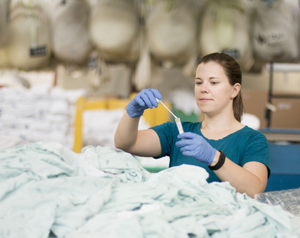by Elizabeth Sharpe
There are certain microscopic bacteria commonly found in hospital settings that make news headlines. They strike fear in most, and for good reason. Infections from these bacteria—Methicillin-resistant Staphylococcus aureus (MRSA), Vancomycin-resistant enterococci (VRE), and Clostridium difficile (C. difficile),—are notoriously hard to treat.
It is their threat to public health that propels Karen Michael, who recently graduated with her PhD in Environmental and Occupational Hygiene from our department. She has spent the majority of her academic career studying these bacteria and ways people can get exposed.
Michael has a bachelor's degree in biology from Georgia State in Atlanta, and an MPH in environmental and occupational health from Drexel University in Philadelphia. While there, she researched MRSA in the indoor air of homes for her MPH thesis.
MRSA can cause mild skin infections or it can be life-threatening if the bacteria gets into the bloodstream. Often called a "super bug," MRSA is resistant to methicillin and to other commonly used antibiotics.
VRE can cause infections in the urinary tract and bloodstream. These bacteria are often multi-resistant and can have fewer treatment options, making them more expensive to treat.
While MRSA, VRE, and C. difficile can be picked up anywhere, they are a large problem in healthcare settings, particularly in hospital rooms that housed patients with one of these infections. The U.S. Centers for Disease Control and Prevention (CDC) lists these bacteria as among the top 18 public health threats in the U.S. A 2015 CDC study found that C. difficile caused almost half a million infections among patients in a single year. There are approximately 66,000 VRE and more than 80,000 MRSA infections every year. All three bacteria can survive for months on dry surfaces.
Michael found her research interests aligned well with Professor Marilyn C. Roberts, who has investigated antibiotic-resistant pathogens in a variety of environmental and occupational health settings.
Together, they worked with a local laundry facility that provides linen-cleaning services for several Seattle-area hospitals to understand if dirty linen could be a source for surface contamination in the facility.
Michael is interested in getting a job in infection prevention, such as in a clinical setting, where she would help prevent or control the spread of disease. In this kind of position, she could help identify problems, and recommend, implement, and monitor policies for disinfection and decontamination to protect patients and workers.
In the hospital environment—door handles, bed rails, remote controls, bed sheets, patient gowns, all of these and more can be reservoirs for bacterial pathogens, because C. difficile, VRE, and MRSA can be shed from people sick with infections and from people who are merely carriers.

In the clinical laundry study, Michael found her data supported her suspicions that dirty linen was a source of MRSA, VRE, and C. difficile contamination; the surfaces where dirty linen was placed, sorted, and washed were more likely be contaminated. She did not find contamination in the areas where the cleaned linen was folded and ironed. And a sampling of the cleaned linen showed that they were free of these three pathogens.
"Working in the field," Michael said, "diversified my experience."
Environmental microbiologists who spend hours at the bench use an arsenal of petri dishes, pipettes, agar—a jello-like material used to grow bacteria—and high-powered microscopes. In the field, Michael hauled out sampling swabs, tape, sharpies, and extras of all of these.
Working in an industrial setting, as opposed to primarily at the bench in a lab, also improved Michael's confidence in her abilities. She sought out resources in the department to increase her knowledge and skills to be effective as a researcher. And one of the managers at the laundry facility called her "Doctor Karen." She realized that in the course of her research, she was seen by others as the scientific expert. "That was a perspective shift," she said.
Her advice to prospective students: figure out the job you want and develop as many of the necessary skills as you can while you're still in school. Be creative with the skills you have and know that these skills can be applied to a different setting.
While working with Professor Roberts, Michael supervised two undergraduates in the laboratory and mentored a third. All worked with Michael on her research. That was management experience, explained Michael.
She also had a number of leadership activities. She was a senator in the Graduate and Professional Student Senate, active in the department's Graduate Student Advisory Committee and the student representative on the department's Curriculum Committee.
She was chosen to be the Graduate Student Speaker at the department's 2016 Graduation Recognition Ceremony last June.
Michael is lead author of three papers published in peer-reviewed journals, and coauthor on a fourth. Most recently, Oxford University Press asked her to author a blog on the research she did on C. difficile.
Now with a doctorate in hand, Michael has the added distinction of being "Dr. Karen."